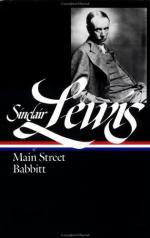IV
She knew that if she was ever to effect any of the “reforms” which she had pictured, she must have a starting-place. What confused her during the three or four months after her marriage was not lack of perception that she must be definite, but sheer careless happiness of her first home.
In the pride of being a housewife she loved every detail—the brocade armchair with the weak back, even the brass water-cock on the hot-water reservoir, when she had become familiar with it by trying to scour it to brilliance.
She found a maid—plump radiant Bea Sorenson from Scandia Crossing. Bea was droll in her attempt to be at once a respectful servant and a bosom friend. They laughed together over the fact that the stove did not draw, over the slipperiness of fish in the pan.
Like a child playing Grandma in a trailing skirt, Carol paraded uptown for her marketing, crying greetings to housewives along the way. Everybody bowed to her, strangers and all, and made her feel that they wanted her, that she belonged here. In city shops she was merely A Customer—a hat, a voice to bore a harassed clerk. Here she was Mrs. Doc Kennicott, and her preferences in grape-fruit and manners were known and remembered and worth discussing . . . even if they weren’t worth fulfilling.
Shopping was a delight of brisk conferences. The very merchants whose droning she found the dullest at the two or three parties which were given to welcome her were the pleasantest confidants of all when they had something to talk about—lemons or cotton voile or floor-oil. With that skip-jack Dave Dyer, the druggist, she conducted a long mock-quarrel. She pretended that he cheated her in the price of magazines and candy; he pretended she was a detective from the Twin Cities. He hid behind the prescription-counter, and when she stamped her foot he came out wailing, “Honest, I haven’t done nothing crooked today—not yet.”
She never recalled her first impression of Main Street; never had precisely the same despair at its ugliness. By the end of two shopping-tours everything had changed proportions. As she never entered it, the Minniemashie House ceased to exist for her. Clark’s Hardware Store, Dyer’s Drug Store, the groceries of Ole Jenson and Frederick Ludelmeyer and Howland & Gould, the meat markets, the notions shop—they expanded, and hid all other structures. When she entered Mr. Ludelmeyer’s store and he wheezed, “Goot mornin’, Mrs. Kennicott. Vell, dis iss a fine day,” she did not notice the dustiness of the shelves nor the stupidity of the girl clerk; and she did not remember the mute colloquy with him on her first view of Main Street.




